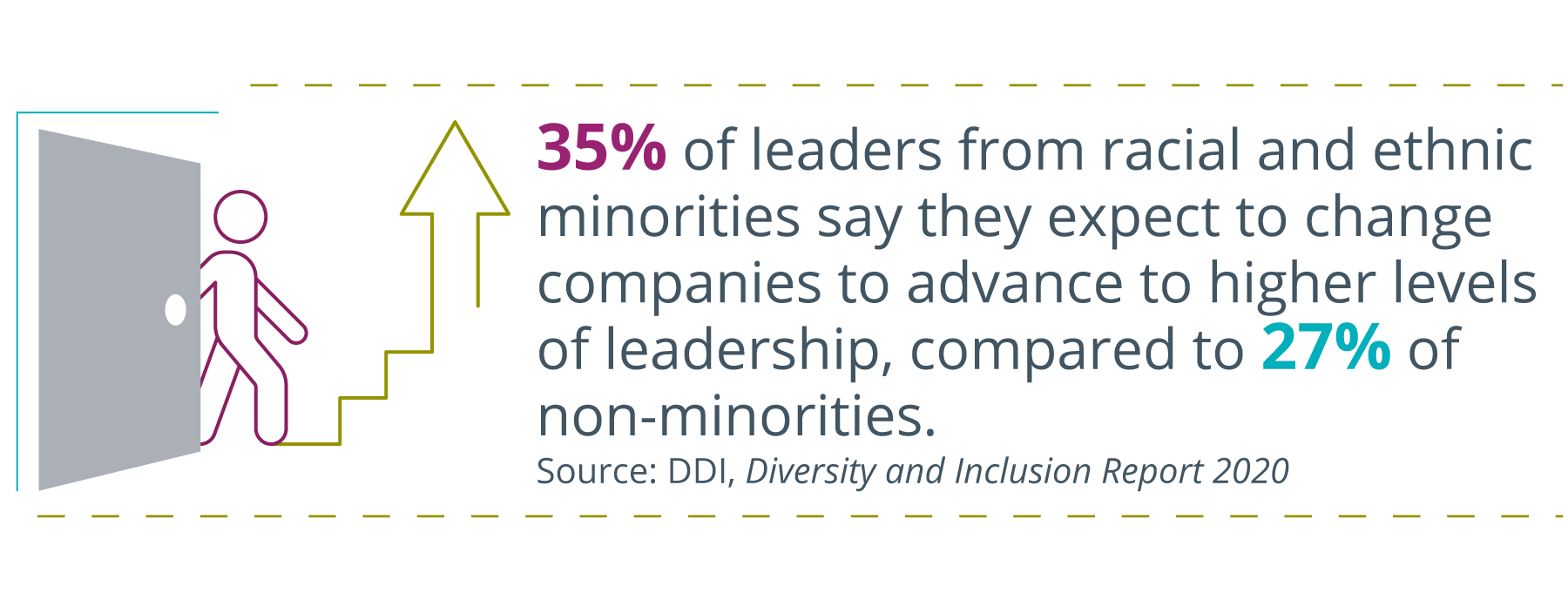Leaders Create the Environment for a Strategy and Culture Shift
Every leader is responsible for creating the environment in which their team can thrive. That’s why when the company shifts its business strategy, the first thing HR needs to do is look at the leadership culture.
In many cases, leaders may need to learn new skills or significantly change their leadership approach to support the culture shift. That’s why this is one of the “macro moments” of leadership when leaders may need a lot of development quickly.
There are a wide range of business strategies that can trigger the need for a culture change. In this section, we’ll walk through an example of a company that has made inclusion a critical part of its talent and business strategy, and how they might develop their leaders to demonstrate inclusion on a daily basis.

Which Leadership Skills Create an Inclusive Culture?
How can leaders create an inclusive culture? It’s going to take more than watching a video on unconscious bias or completing an online training course. Leaders need to build skills that enable them to practice inclusion every day.
In our research, we’ve identified seven leadership behaviors that drive inclusion:
- Build Empathy: Leaders need to be able to put themselves in the shoes of everyone on their team, and understand how exclusion may feel to them and affect their performance.
- Communicate Inclusively: Inclusion must live in the micro moments of every leadership interaction, ensuring every team member feels valued, respected, trusted, supported, and included.
- Run Inclusive Meetings: Leaders need to include the right people —for ideation and decision making—and empower them to contribute fully.
- Delegate for Opportunity: It’s easy for leaders to get into a habit of giving the same assignments to the same people. Leaders should assign projects equally and offer opportunities fairly.
- Give Honest Feedback: Many leaders are uncomfortable giving honest feedback to people who are different from themselves. But failure to provide honest feedback robs team members of critical developmental insight for future success. Leaders need to give structure to both their positive and developmental feedback, and ensure everyone on the team is getting the same types and equal amounts of feedback.
- Coach Inclusively for Growth: People from different backgrounds are often left out of informal networks and conversations that help them learn, grow, and influence others. Leaders need strong coaching skills to accelerate performance and use fair performance standards across their team.
- Resolve Conflict Fairly: Healthy conflict on diverse teams drives more well-rounded decisions and innovation. But it’s also critical that leaders pay special attention to how they resolve conflict, ensuring that multiple viewpoints are heard and evaluated.

Sample Program to Develop Inclusive Leaders
So how can you support leaders as they strive to become more inclusive in their everyday leadership moments?
Here are key elements that you can include as you design your leadership program:
- Self-Insight Tools: Self-awareness is critical when it comes to inclusion. There are a variety of ways to build awareness. One tool we use is a self-assessment called Inclusion in Action, which invites leaders to reflect on what they do each day that fosters or hinders an inclusive company culture. Another assessment asks leaders to think about how their reactions focus on themselves or others.
- Try new technology: Because self-awareness is so crucial to inclusion, this may also be a time to try something new to spark engagement with leaders. In this case, we have used virtual reality to drive empathy for inclusion, which can be a powerful catalyst to build commitment.
- Courses to Build Skills: Whether live onsite, in a virtual classroom, or self-paced online, courses can help leaders weave inclusion into their everyday interactions. For example, we recommend these courses to help leaders practice inclusion within the context of their broader leadership skills:
- Microcourses to Boost Learning: As leaders begin shifting how they think about leadership, microcourses can help them to stay engaged and deepen their learning. Here are some of the topics we cover in a learning journey to support inclusion:
- On-Demand Development Tools: Creating an inclusive culture takes time. It’s important for leaders to have access to ongoing support through tools and resources like job aids, practice exercises, and discussion planners.
In addition to the above resources, we’ve also worked with organizations to design executive stakeholder sessions, build leadership habits through ongoing feedback, and measure program effectiveness to demonstrate behavior change and impact on the business.
![client quote written out, with heart icons underneath it: “When we did the [DDI] experience with our inclusion council, I had a person on my team who sat in, and we had a conversation afterward and he said he was amazed that senior leaders can experience exclusion, too. That was a real ‘wow’ moment.” credit of Taiwan Brown, Head of Diversity and Inclusion at Realpage, in Human Resource Executive magazine](https://assets-us-01.kc-usercontent.com:443/469992e5-7cbd-0032-ead4-f2db9237053a/fabfbe99-d92d-4cb4-8481-309e7db84b2d/04_Exploring_02_NFLSBSS_04.png)
Better Leaders for a Better Future
When your company is undergoing a shift in business strategy, one of the biggest mistakes you can make is to assume your leaders know how to execute it. That won’t cut it. As the example we shared shows, it can take significant effort to change the way your leaders think and operate.
Your leaders need targeted support to build the skills wired to your strategy. So think carefully about how you can support your leaders in this moment. And most importantly, make sure that leaders are getting consistent support and messaging across the board. If you want to see your culture shift, every leader needs to be on board.
